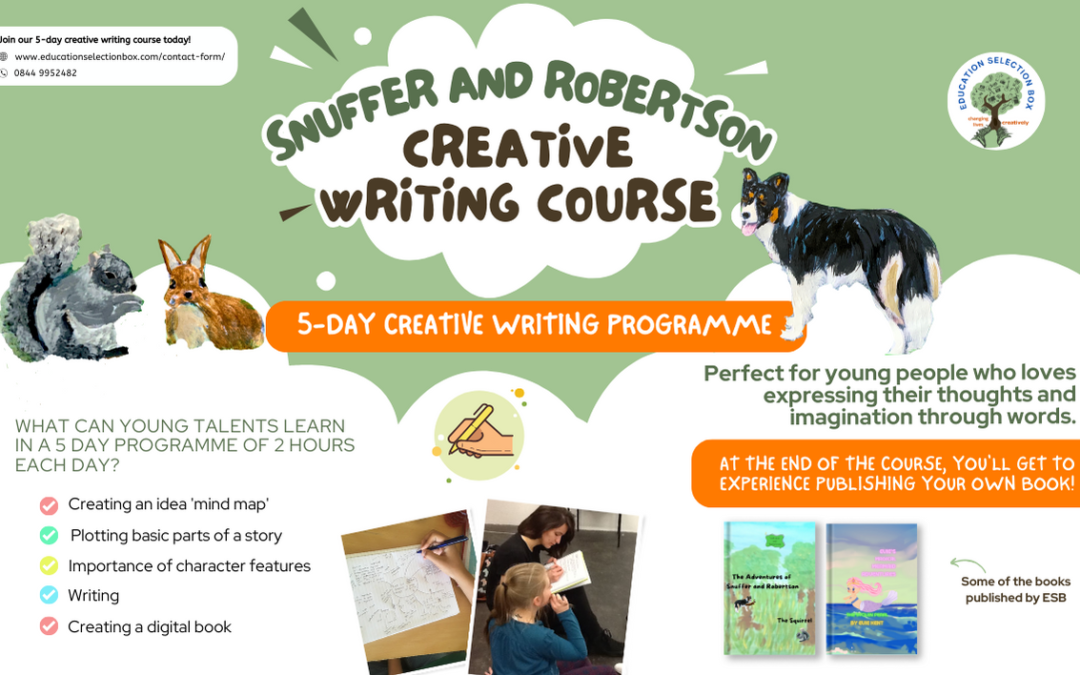
by Helen Kenworthy | Apr 24, 2024 | Uncategorized
Tutors bridge the gap between students and their academic goals, providing personalized attention and support that often goes beyond the traditional classroom setting. At Education Selection Box, we believe that any child can enjoy learning with the right support, and we’re here to celebrate the contributions of tutors in the education sector.
This blog post is a tribute to the excellence in education, highlighting the role of tutors in shaping the future of our students.
Defining the Role of Tutors
Tutors are the backbone of personalized learning, offering a one-on-one approach that traditional classroom settings cannot match. They provide students with the flexibility to learn at their own pace, addressing specific areas of difficulty and enhancing understanding through tailored instruction.
Strategies for Success
Successful tutors employ a variety of strategies to engage their students and foster a love for learning. These include:
- Effective Communication: Building a strong rapport with students, understanding their learning style, and adapting instruction to meet their needs.
- Setting Realistic Expectations: Helping students set achievable goals and providing constructive feedback to keep them motivated.
- Fostering a Love for Learning: Encouraging curiosity and a passion for knowledge, guiding students to explore their interests and discover new passions.
The Role of Tutors in Preparing Students for the Future
1. Career Preparation
Tutors play a crucial role in preparing students for their future careers. They provide students with the skills and knowledge needed to succeed in the workforce, ensuring they are well-equipped to navigate the professional world.
2. Personal Development
Beyond academic achievements, tutors contribute significantly to students’ personal development. They help build confidence, resilience, and a positive attitude towards learning, equipping students with the tools to face life’s challenges head-on.
3. Community Impact
Tutors also make a difference in their communities, not just through their work with students but also through their broader contributions to education. They often volunteer their time to mentor younger students, share their expertise, and inspire the next generation of learners.
4. Promoting Personal Development
Tutors play a pivotal role in promoting personal development among students. By acting as leaders, tutors help students build confidence, develop resilience, improve problem-solving and decision-making skills, and manage stress effectively. They guide students in setting personal goals, encourage them to overcome obstacles, and instill in them a sense of responsibility and accountability. This leadership role is crucial in shaping students’ future success, as it equips them with the essential life skills needed to navigate future challenges and opportunities 1.
5. Shaping Future Success
The leadership role of tutors is instrumental in shaping students’ future success. By nurturing essential life skills, tutors help students prepare for future challenges and opportunities. Students who have been guided by tutor-leaders are often better equipped to navigate college, careers, and life transitions. This holistic approach ensures that students are not only academically prepared but also emotionally and socially equipped to face the demands of the real world 1.
6. Holistic Development of Students
Tutors play an instrumental role in the holistic development of students. Beyond imparting academic knowledge, they guide students in developing essential life skills such as critical thinking, problem-solving, time management, and effective communication. They help students identify their strengths and weaknesses, work on their areas of improvement, and enhance their self-confidence and self-awareness. Thus, the role of a tutor encompasses more than teaching subjects; it involves shaping well-rounded individuals who are prepared for life’s challenges
Strategies for Tutors to Enhance Their Leadership Role
Tutors can significantly influence the lives of their students by embracing their role as leaders. By adopting certain strategies, tutors can enhance their leadership abilities and maximize their impact on students’ academic, personal, and future success. These strategies include:
- Fostering a Positive Learning Environment: Tutors can create a supportive and motivating learning environment that encourages students to explore their interests and develop a love for learning.
- Personalized Instruction: Tailoring instruction to meet the unique needs and learning styles of each student can significantly enhance their understanding and retention of information.
- Regular Feedback and Assessment: Providing constructive feedback and regular assessments can help students set achievable goals and stay motivated.
- Encouraging Independent Learning: Encouraging students to take initiative in their learning can foster a sense of responsibility and accountability, preparing them for future challenges
Conclusion
In conclusion, tutors are the unsung heroes of education, playing a pivotal role in shaping the future of our students. Their dedication, passion, and commitment to excellence in education are what truly make a difference. As we continue to navigate the evolving landscape of education, let’s take a moment to recognize and celebrate the incredible work of tutors everywhere. Together, we can ensure that every child has the opportunity to enjoy learning and achieve their full potential.

by Helen Kenworthy | Apr 16, 2024 | Uncategorized
Storybooks are a treasured part of a child’s early years, offering a magical window into a world of imagination, learning, and growth. Whether you’re a parent looking to enrich your child’s early years or an educator seeking innovative ways to engage your students, this guide will equip you with the knowledge and tools to make storybooks a central part of your child’s learning experience
This week’s blog post aims to provide parents and educators with insights into the benefits of reading storybooks to children, tips on selecting age-appropriate storybooks, and strategies for encouraging creativity through storybooks.
Benefits of Reading Storybooks to Children
Reading storybooks to children is a fundamental part of their development. Here are some of the key benefits:
1. Enhances Language Skills
Storybooks help children develop their language skills. They learn new words, understand sentence structure, and improve their vocabulary. Reading aloud also helps in pronunciation and comprehension.
2. Fosters Emotional Intelligence
Through stories, children learn about a wide range of emotions and how to express them. Storybooks teach empathy, kindness, and the importance of understanding others’ feelings.
3. Encourages Imagination and Creativity
Storybooks ignite children’s imagination, encouraging them to visualize the stories and create their own narratives. This process enhances their creativity and problem-solving skills.
4. Develops Social Skills
Reading stories together as a family can strengthen social bonds. It teaches children about sharing, taking turns, and the importance of listening to others.
5. Introduces Basic Concepts
Early storybooks often include simple concepts like numbers, colors, and shapes. This foundational knowledge lays the groundwork for future learning.
Selecting Age-Appropriate Storybooks
Choosing the right storybook is crucial for a child’s development. Here are some tips for selecting age-appropriate storybooks:
1. Consider the Child’s Developmental Stage
Different ages require different types of stories. For toddlers, choose simple, rhymed stories with bright colors. As children grow, introduce stories with more complex themes and vocabulary.
2. Look for High-Quality Illustrations
Illustrations play a significant role in a child’s understanding and enjoyment of a story. Look for books with vibrant, engaging illustrations that complement the text.
3. Read Reviews and Recommendations
Parents and educators often share their favorite storybooks. Reading reviews and recommendations can help you discover age-appropriate books that are both educational and enjoyable.
4. Consider the Theme and Content
Choose stories that align with your child’s interests and values. Avoid stories with themes that are inappropriate for their age.
Encouraging Creativity Through Storybooks
Storybooks are not just about entertainment; they are a powerful tool for fostering creativity. Here are some strategies:
1. Engage in Discussion
After reading a storybook, engage your child in a discussion about the story. Ask them what they liked, what they didn’t like, and what they would change. This encourages critical thinking and creativity.
2. Draw and Create
Encourage your child to draw or create their own versions of the stories they love. This can be as simple as doodling on a piece of paper or creating a puppet show based on the story.
3. Write Their Own Stories
Help your child write their own stories, incorporating elements from the storybooks they’ve enjoyed. This can be a fun way to practice writing skills and express their creativity.
4. Role-Play
Role-playing stories can be a fantastic way to encourage creativity. Children can act out the stories, creating their own versions and adding new characters or plot twists.
Conclusion
Storybooks are a vital tool in a child’s development, offering countless benefits from enhancing language skills to fostering creativity. By selecting age-appropriate storybooks and engaging in creative activities, parents and educators can support their children’s growth in a fun and engaging way. Remember, the most important thing is to make the reading experience enjoyable and interactive, creating a love for stories that will last a lifetime
You can order our Snuffer and Robertson paperback on Amazon or the e-book version here

by Helen Kenworthy | Apr 10, 2024 | Education, Resources, Uncategorized
Welcome to our journey through the enchanting world of “Snuffer & Robertson,” a delightful children’s book that transports readers into the heart of a friendship between a wise old collie dog named Robertson and a playful rabbit named Snuffer. This blog will take you on a tour of the book’s captivating story, its beautiful illustrations, and why it’s a must-read for every child aged 3 to 8.
Background of “Snuffer & Robertson”
“Snuffer & Robertson” is the first in a series of books that celebrate friendship, acceptance of differences, and the joy of adventure. Written by Helen and Val Lewis, a mother-daughter duo with a wealth of experience in working with young children, this book is not just a story but a journey of discovery and learning. The story of Snuffer and Robertson is inspired by the friendship between Robertson, a collie dog, and Freddie, a much-loved furry member of the Lewis family.
The Art and Design of “Snuffer & Robertson”
The book’s illustrations are hand-drawn, showcasing the unique art style of Helen and Val Lewis. The designs are vibrant and engaging, with a focus on the characters’ expressions and the lush, woodland setting that serves as their playground. The layout is designed to encourage reading together, with lines split into two colors for easy reading by younger children, and sentences of varying difficulty to challenge and engage readers of all ages.
Why Every Kid Should Read “Snuffer & Robertson”
- “Snuffer & Robertson” is more than just a children’s book; it’s a tool for learning and growth. The story, filled with rhymes and adventures, is written with simple sentences, making it accessible for young readers to read on their own.
- It encourages children to practice different tenses, explore new words, and engage in discussions about language structures.
- The book also supports the work of the RYTC (Really Youthful Theatre Company) and Education Selection Box, contributing to children’s art and drama therapy charities in the West Midlands.
Reader Recommendations
For children aged 3 to 8, “Snuffer & Robertson” is a perfect blend of fun, learning, and emotional connection. Whether you’re reading it together, by yourself, or with a parent, this book is sure to captivate and inspire.
To further explore the themes and lessons in the book, consider enrolling in the RYTC Drama Course or the Education Selection Box Creative Writing Course.
Conclusion
“Snuffer & Robertson” is a testament to the power of storytelling in education. It’s a book that not only entertains but also encourages children to reach their full potential. Whether you’re a parent looking for a book to share with your child or a teacher seeking resources for your classroom, “Snuffer & Robertson” is a gem worth discovering.
Where to Purchase
You can order the paperback on Amazon or the e-book version here

by Helen Kenworthy | Apr 2, 2024 | Education
Hello, high schoolers! Today, we’re diving into a topic that might seem a bit intimidating at first glance, but trust me, it’s going to be a game-changer. We’re going to explore “Mathematics Beyond the Textbook: Real-World Applications for High Schoolers.” This isn’t just about solving equations or memorizing formulas; it’s about understanding how math is everywhere around us, in our daily lives, and how it can help us solve real-world problems.
Why is Mathematics Important?
Before we dive into the applications, let’s take a moment to appreciate the beauty and importance of mathematics. Mathematics is the language of the universe. It’s the foundation of everything from the architecture of buildings to the algorithms that power our smartphones. It’s the tool that allows us to predict weather patterns, calculate the trajectory of a rocket, and even understand the complexities of the human brain.
But why is it so important for high schoolers? Well, for one, a solid understanding of mathematics can open up a world of opportunities. Whether you’re aiming for a career in engineering, finance, or even a career in the arts, a strong foundation in math can give you an edge. It’s not just about getting good grades; it’s about understanding the world around you and how you can make a difference.
Real-World Applications of Mathematics
Now, let’s get into the nitty-gritty. Here are some real-world applications of mathematics that you might find surprising:
1. Navigation and GPS
Have you ever wondered how your phone knows where you are? That’s thanks to mathematics. GPS systems use complex equations to calculate your position based on the time it takes for a signal to travel from the satellite to your phone. Without math, we wouldn’t be able to navigate the world with ease.
2. Cryptography
Imagine a world where your emails and messages are completely secure. That’s possible thanks to cryptography, a field of mathematics that involves creating codes to encrypt and decrypt messages. This is how your online banking information is protected.
3. Climate Modeling
Climate change is a pressing issue, and mathematicians are at the forefront of understanding and predicting its effects. By using mathematical models, scientists can predict future climate patterns and help us develop strategies to mitigate the impact.
4. Sports Analytics
From predicting the outcome of a game to analyzing player performance, sports analytics relies heavily on mathematics. Data scientists use statistical models to make predictions and decisions, helping teams and players improve.
5. Financial Markets
The stock market is a complex system that relies on mathematical models to predict future trends. These models help investors make informed decisions, and they’re crucial for the economy as a whole.
Conclusion
As high schoolers, you might not see the direct application of math in your daily life right now. But trust me, it’s there. Every time you use a smartphone, drive a car, or even when you’re planning your college courses, you’re using math. And the more you understand it, the more you’ll see its impact on the world around you.
So, let’s embrace mathematics not just as a subject to be studied, but as a tool to understand and shape the world. After all, math is the language of the universe, and it’s up to us to learn and speak it.
Remember, the key to mastering math is not just memorizing formulas but understanding the principles behind them. So, keep exploring, keep asking questions, and keep learning. Because the world of mathematics is vast, and there’s so much more to discover.
Happy learning, and may your journey through math be as exciting and rewarding as it is enlightening!

by Helen Kenworthy | Mar 26, 2024 | Education
Learning mathematics can sometimes feel like a daunting task, but with the right strategies and techniques, you can transform this challenge into a rewarding journey. Whether you’re a student aiming to improve your grades or a parent seeking to support your child’s academic success, this guide will provide you with insights and strategies to help you effectively learn mathematics.
Understanding the Basics
The foundation of any learning endeavor is a solid understanding of the basics. In mathematics, this means having a strong grasp of fundamental concepts such as addition, subtraction, multiplication, and division. These operations form the building blocks upon which more complex mathematical ideas are built. Spend time reviewing these concepts, ensuring you understand them thoroughly before moving on to more advanced topics.
Study Techniques
1. Spaced Repetition
Spaced repetition is a powerful study technique that involves reviewing information at increasing intervals over time. This method is particularly effective for memorizing formulas, theorems, and historical facts in mathematics. The idea is to review the material immediately after learning it, then review it again after a few days, weeks, or months, depending on how well you remember it. This technique helps reinforce memory and understanding over time.
2. Active Recall
Active recall is the practice of actively trying to remember information without looking at the material. This technique strengthens your memory and understanding of the material. After studying, take a few minutes to recall the information without looking at your notes. This can be done by writing the information in your own words or explaining it to someone else.
3. Interleaving
Interleaving involves mixing different topics or types of problems during a study session. This technique helps improve problem-solving skills and adaptability in mathematics. Instead of focusing on one topic at a time, mix problems from different areas of mathematics to challenge your brain. This approach can enhance your ability to apply mathematical concepts in various contexts and improve your overall problem-solving skills.
Time Management Tips
- Prioritize Your Study Time
Identify the most challenging topics and allocate more time to study them. Prioritize your study sessions based on the difficulty level of the material and your current understanding. This approach ensures that you focus your efforts on areas where you need the most improvement.
- Break Down Large Study Sessions
Breaking down large study sessions into smaller, manageable chunks can make studying more efficient and less overwhelming. For example, study for 25 minutes, then take a 5-minute break before continuing. This technique, known as the Pomodoro Technique, can help maintain focus and productivity. It also prevents burnout, allowing you to study more effectively over longer periods.
Approaching Different Types of Problems
Before attempting to solve a problem, take a moment to understand what is being asked. Break down the problem into smaller, manageable parts. This approach can make complex problems seem more approachable. Understanding the problem is the first step to finding a solution.
Visual aids, such as diagrams, charts, and graphs, can be incredibly helpful in understanding mathematical concepts. They can provide a visual representation of abstract ideas, making it easier to grasp complex concepts. Visual aids can also help you see patterns and relationships that might not be immediately apparent in text or numbers.
- Practice, Practice, Practice
The key to mastering mathematics is practice. The more problems you solve, the better you’ll become at identifying patterns, applying formulas, and understanding mathematical concepts. Practice is not just about repetition; it’s about understanding the underlying principles and applying them in different contexts.
We encourage you to share your own strategies and experiences in the comments section below. Your insights can inspire others and help create a community of learners who support each other’s growth in mathematics. Sharing your strategies can also provide valuable feedback and help you refine your own learning process.
Conclusion
Learning mathematics is a journey, and with the right strategies and a positive mindset, you can navigate this journey with confidence and success. Remember, every challenge is an opportunity to learn and grow. So, embrace the process, stay curious, and keep exploring the world of mathematics. Whether you’re tackling algebra, calculus, or statistics, the key to mastery lies in understanding the basics, applying effective study techniques, managing your time wisely, and practicing regularly.





